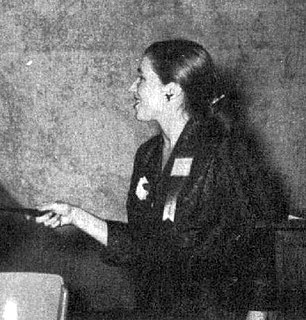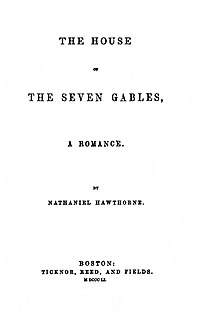Related Research Articles

Julia Carolyn Child was an American cooking teacher, author, and television personality. She is recognized for bringing French cuisine to the American public with her debut cookbook, Mastering the Art of French Cooking, and her subsequent television programs, the most notable of which was The French Chef, which premiered in 1963.

Amy Lawrence Lowell was an American poet of the imagist school, which promoted a return to classical values. She posthumously won the Pulitzer Prize for Poetry in 1926.

Walter Harry Pitts, Jr. was a logician who worked in the field of computational neuroscience. He proposed landmark theoretical formulations of neural activity and generative processes that influenced diverse fields such as cognitive sciences and psychology, philosophy, neurosciences, computer science, artificial neural networks, cybernetics and artificial intelligence, together with what has come to be known as the generative sciences. He is best remembered for having written along with Warren McCulloch, a seminal paper in scientific history, titled "A Logical Calculus of Ideas Immanent in Nervous Activity" (1943). This paper proposed the first mathematical model of a neural network. The unit of this model, a simple formalized neuron, is still the standard of reference in the field of neural networks. It is often called a McCulloch–Pitts neuron. Prior to that paper, he formalized his ideas regarding the fundamental steps to building a Turing machine in "The Bulletin of Mathematical Biophysics" in an essay titled "Some observations on the simple neuron circuit".

Julian Clare May was an American science fiction, fantasy, horror, science and children's writer who also used several literary pseudonyms. She was best known for her Saga of Pliocene Exile and Galactic Milieu Series books.

Theodora Sarah Orne Jewett was an American novelist, short story writer and poet, best known for her local color works set along or near the southern coast of Maine. Jewett is recognized as an important practitioner of American literary regionalism.
Fanshawe is a novel written by American author Nathaniel Hawthorne. It was his first published work, which he published anonymously in 1828.

Galway Mills Kinnell was an American poet. He won the Pulitzer Prize for Poetry for his 1982 collection, Selected Poems and split the National Book Award for Poetry with Charles Wright. From 1989 to 1993 he was poet laureate for the state of Vermont.

James Thomas Fields was an American publisher, editor, and poet. His business, Ticknor and Fields, was a notable publishing house in 19th century Boston.
Helen Smith Bevington was an American poet, prose writer, and educator. Her most noted book, Charley Smith's Girl (1965), was "banned by the library in the small town of Worcester, N.Y., where she grew up, because the book tells of her minister father's having been divorced by her mother for affairs that he was carrying on with younger female parishioners."

Elinor Lipman is an American novelist, short story writer, and essayist.
The Massachusetts Institute of Technology (MIT), a private research university in Cambridge, Massachusetts in the United States, has been mentioned in many works of cinema, television, music, and the written word. MIT's widespread overall reputation has greater influence on its role in popular culture than does any particular aspect of its history or its student lifestyle. Because MIT is well known as a seedbed for technology and technologists, the makers of modern media are able to use it to effectively establish character, in a way that mainstream and international audiences can immediately understand. A smaller number of creative works use MIT directly as their scene of action.

Virginia Lee Burton, also known by her married name, Virginia Demetrios, was an American illustrator and children's book author. She wrote and illustrated seven children's books, including Mike Mulligan and His Steam Shovel (1939), and The Little House (1943), which won the Caldecott Medal. She also illustrated six books by other authors.
Suzanne Hubbell was an American author. Her books A Country Year and A Book of Bees were selected by The New York TimesBook Review as Notable Books of the Year. She also wrote for The New Yorker, the St. Louis Post-Dispatch, Smithsonian and Time, and was a frequent contributor to the "Hers" column of The New York Times.

The House of the Seven Gables: A Romance is a Gothic novel written beginning in mid-1850 by American author Nathaniel Hawthorne and published in April 1851 by Ticknor and Fields of Boston. The novel follows a New England family and their ancestral home. In the book, Hawthorne explores themes of guilt, retribution, and atonement, and colors the tale with suggestions of the supernatural and witchcraft. The setting for the book was inspired by the Turner-Ingersoll Mansion, a gabled house in Salem, Massachusetts, belonging to Hawthorne's cousin Susanna Ingersoll, as well as ancestors of Hawthorne who had played a part in the Salem Witch Trials of 1692. The book was well received upon publication and later had a strong influence on the work of H. P. Lovecraft. The House of the Seven Gables has been adapted several times to film and television.

Cynthia von Buhler is an American artist, author, playwright, performer, and producer.
Lillian Faderman is an American historian whose books on lesbian history and LGBT history have earned critical praise and awards. The New York Times named three of her books on its "Notable Books of the Year" list. In addition, The Guardian named her book, Odd Girls and Twilight Lovers, one of the Top 10 Books of Radical History. She was a professor of English at California State University, Fresno, which bestowed her emeritus status, and a visiting professor at University of California, Los Angeles (UCLA). She retired from academe in 2007. Faderman has been referred to as "the mother of lesbian history" for her groundbreaking research and writings on lesbian culture, literature, and history.
Daphne Marie Rooke was a South African author of works such as "Mittee", "Ratoons" and "Wizards' Country". She also wrote travel articles and books for children set in India, Australia, New Zealand, and South Africa.
Janna Malamud Smith is an American non-fiction writer. She was born in Corvallis, Oregon in 1952, the second of two children born to Ann DeChiara Malamud and the writer Bernard Malamud. She grew up in Oregon, then in Bennington, Vermont, and Cambridge, Massachusetts. She received her A.B. from Harvard University in 1973, majoring in American history and literature, and an M.S.W. in 1979 from Smith College. She practices and teaches psychotherapy in the Boston area. She is married to David Smith, and is the mother of two children.
The Leary–Lettvin debate was a May 3, 1967 debate between Dr. Jerome Lettvin, a medical doctor and professor at MIT, and Dr. Timothy Leary, a licensed psychologist, about the merits and dangers of the hallucinogenic drug LSD. It took place in the Kresge Auditorium at the Massachusetts Institute of Technology.
Helen Schulman is an American novelist, short story, non-fiction, and screenwriter. Her fifth novel, This Beautiful Life, was an international bestseller, and was chosen in the 100 Notable Books of 2011 by the New York Times Book Review.
References
- ↑ John Underwood (May 26, 1975). "Beating Their Brains Out". Sports Illustrated. Retrieved 24 May 2011.
In the wrestling and fencing rooms, faculty and students submitted themselves to Maggie Lettvin for overhauls. Maggie is svelte, black-haired and 48, "The Beautiful Machine" of Boston educational television. Her roly-poly husband is an MIT biology and electrical engineering professor.
- ↑ "WGBH Program list — to 2000". WGBHalumni.org. Retrieved 2011-05-24.
- ↑ Burtoff, Barbara (December 27, 1978). "Just a Simple Brunch for 120 College Men". The New York Times . Retrieved May 23, 2017.